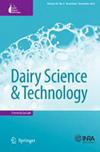白富拉尼奶牛产奶量与乳房形态性状的关系
Q2 Agricultural and Biological Sciences
引用次数: 0
摘要
研究了白富拉尼奶牛产奶量与乳房形态性状的关系。58头明显健康的泌乳早期奶牛在第二胎、第三胎和第四胎被用于研究。试验数据包括单次挤奶试验日产奶量(TDMY)和乳长(UL)、乳宽(UW)、乳深(UD)、前乳长(FTL)、后乳长(RTL)、前乳直径(FTD)和后乳直径(RTD)。胎次对TDMY和乳房形态特征无显著影响。TDMY、UL、UW和UD之间呈显著正相关。值得注意的是,不同胎次的UL和TDMY之间的表型相关性最强。乳头测量值与TDMY无显著相关。采用逐步回归和主成分回归来评估产奶量与乳房形态性状之间的关系。有趣的是,UL是进入简化模型的唯一特征。结果表明产奶量和乳房长度之间可能存在遗传相关性。因此,由于乳房构象特征是可遗传的,因此在选择白富拉尼奶牛的乳房长度时,预计产奶量会产生相关反应。本文章由计算机程序翻译,如有差异,请以英文原文为准。
Relationship between Milk Yield and Udder Morphology Traits in White Fulani Cows
The study examined the relationship between milk yield and udder morphology traits in White Fulani cows. Fifty-eight apparently healthy cows in early lactation at 2nd, 3rd, and 4th parity were used in the study. The data obtained from the cows were test day milk yield (TDMY) from single milking and udder morphology traits comprising udder length (UL), udder width (UW), udder depth (UD), fore teat length (FTL), rear teat length (RTL), fore teat diameter (FTD), and rear teat diameter (RTD). There was no significant effect of parity on TDMY or the udder morphology traits. Phenotypic correlations between TDMY, UL, UW, and UD were positive and significant. Notably, phenotypic correlations between UL and TDMY at different parities were the strongest. Teat measurements had no significant correlation with TDMY. Stepwise and principal component regressions were implemented to assess the relationship between milk yield and udder morphology traits. Interestingly, UL was the only trait that entered the reduced models. The results suggest a probable genetic correlation between milk yield and udder length. Therefore, since udder conformation traits are heritable, when selecting for udder length in White Fulani cows, a correlated response in milk yield is expected.
求助全文
通过发布文献求助,成功后即可免费获取论文全文。
去求助
来源期刊

Dairy Science & Technology
农林科学-食品科技
CiteScore
2.30
自引率
0.00%
发文量
0
审稿时长
2 months
期刊介绍:
Information not localized
 求助内容:
求助内容: 应助结果提醒方式:
应助结果提醒方式:


